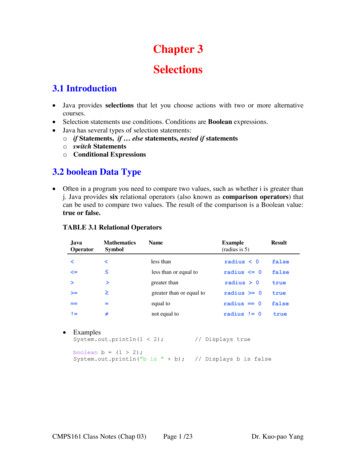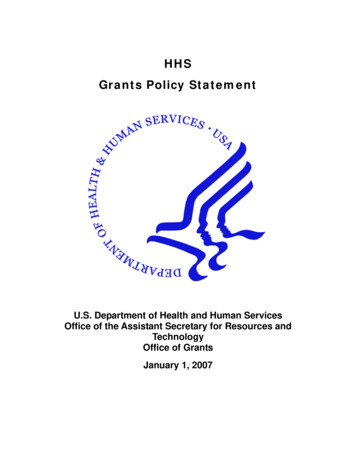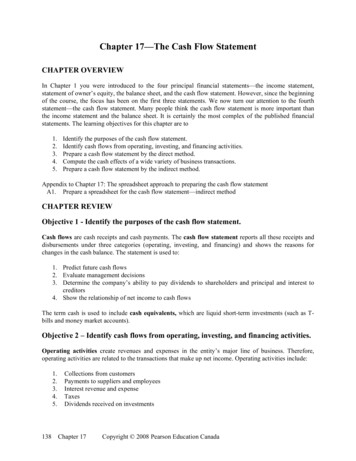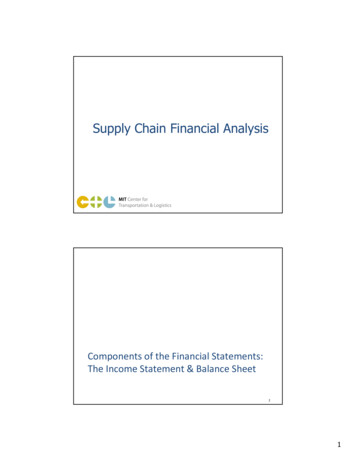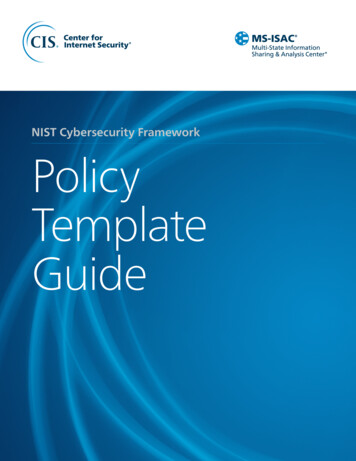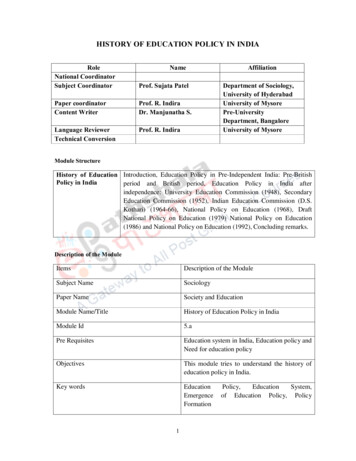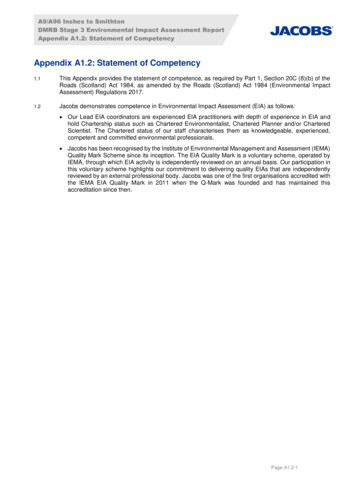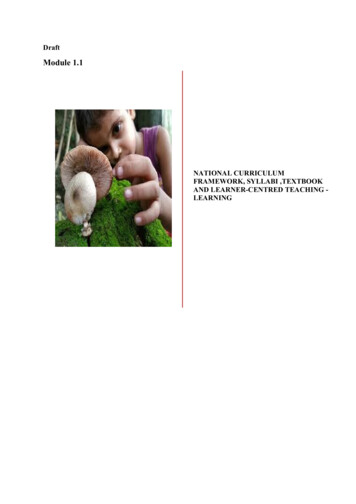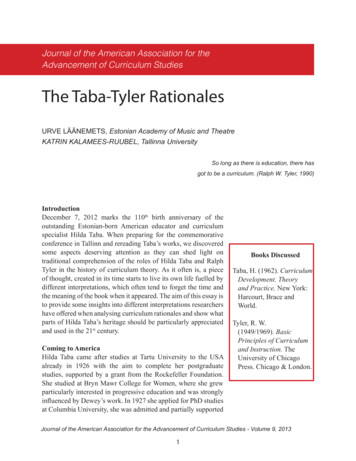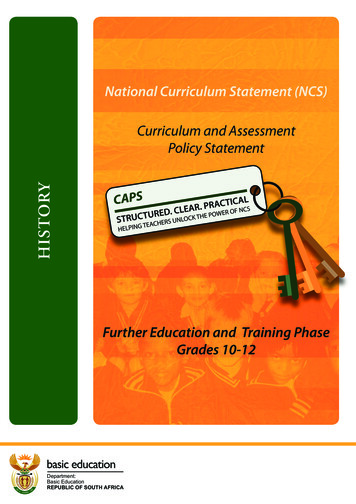
Transcription
National Curriculum Statement (NCS)HISTORYCurriculum and AssessmentPolicy StatementFurther Education and Training PhaseGrades 10-12
CURRICULUM AND ASSESSMENT POLICY STATEMENTGRADES 10-12HISTORY
HISTORY GRADES 10-12Department of Basic Education222 Struben StreetPrivate Bag X895Pretoria 0001South AfricaTel: 27 12 357 3000Fax: 27 12 323 0601120 Plein Street Private Bag X9023Cape Town 8000South AfricaTel: 27 21 465 1701Fax: 27 21 461 8110Website: http://www.education.gov.za 2011 Department of Basic EducationISBN: 978-1-4315-0581-4Design and Layout by: Ndabase Printing SolutionPrinted by: Government Printing WorksiiCURRICULUM AND ASSESSMENT POLICY STATEMENT (CAPS)
HISTORY GRADES 10-12FOREWORDOur national curriculum is the culmination of our efforts over a period of seventeen years to transform the curriculumbequeathed to us by apartheid. From the start of democracy we have built our curriculum on the values that inspiredour Constitution (Act 108 of 1996). The Preamble to the Constitution states that the aims of the Constitution are to: heal the divisions of the past and establish a society based on democratic values, social justice and fundamentalhuman rights; improve the quality of life of all citizens and free the potential of each person; lay the foundations for a democratic and open society in which government is based on the will of the peopleand every citizen is equally protected by law; and build a united and democratic South Africa able to take its rightful place as a sovereign state in the family ofnations.Education and the curriculum have an important role to play in realising these aims.In 1997 we introduced outcomes-based education to overcome the curricular divisions of the past, but the experienceof implementation prompted a review in 2000. This led to the first curriculum revision: the Revised National CurriculumStatement Grades R-9 and the National Curriculum Statement Grades 10-12 (2002).Ongoing implementation challenges resulted in another review in 2009 and we revised the Revised NationalCurriculum Statement (2002) to produce this document.From 2012 the two 2002 curricula, for Grades R-9 and Grades 10-12 respectively, are combined in a single documentand will simply be known as the National Curriculum Statement Grades R-12. The National Curriculum Statement forGrades R-12 builds on the previous curriculum but also updates it and aims to provide clearer specification of whatis to be taught and learnt on a term-by-term basis.The National Curriculum Statement Grades R-12 accordingly replaces the Subject Statements, Learning ProgrammeGuidelines and Subject Assessment Guidelines with the(a)Curriculum and Assessment Policy Statements (CAPS) for all approved subjects listed in this document;(b)National policy pertaining to the programme and promotion requirements of the National CurriculumStatement Grades R-12; and(c)National Protocol for Assessment Grades R-12.MRS ANGIE MOTSHEKGA, MPMINISTER OF BASIC EDUCATIONCAPSi
HISTORY GRADES 10-12iiCURRICULUM AND ASSESSMENT POLICY STATEMENT (CAPS)
HISTORY GRADES 10-12CONTENTSSECTION 1: INTRODUCTION TO THE CURRICULUM AND ASSESSMENT POLICY STATEMENTS.31.1Background.31.2Overview.31.3General aims of the South African Curriculum.41.4Time allocation.61.4.1 Foundation Phase. 61.4.2 Intermediate Phase. 61.4.3 Senior Phase. 71.4.4 Grades 10 -12. 7SECTION 2: INTRODUCTION TO HISTORY. 82.1What is History?.82.2Specific Aims.82.3Skills and Concepts.82.3.1 Tables of Skills. 82.3.2 Concepts. 102.4Rationale for the organisation of the content and weighting. 102.5Overview of FET topics. 12SECTION 3: OVERVIEW OF TOPICS PER TERM AND ANNUAL TEACHING PLANS. 133.1Content for Grade 10.133.2Content for Grade 11.193.3Content for Grade 12.25CAPS1
HISTORY GRADES 10-12SECTION 4: ASSESSMENT IN HISTORY. 324.1What is Assessment?. 324.1.1 Assessment in History. 324.2Informal or daily assessment. 324.3Formal Assessment.334.3.1 Cognitive levels and abilities covered during formal assessment. 334.4Programme of Assessment. 344.4.1 Programme of assessment and weighting of tasks. 344.4.2 Examinations. 374.4.3 Global assessment of essays. 414.4.4 Assessment of source-based questions. 424.4.5 Guidelines for Grade 12 examination papers. 424.5Recording and Reporting. 514.5.1 Codes and percentages for recording and reporting. 514.6Moderation of Assessment. 514.6.1 Moderation in History. 514.7General.522CURRICULUM AND ASSESSMENT POLICY STATEMENT (CAPS)
HISTORY GRADES 10-12SECTION 1INTRODUCTION TO THE CURRICULUM AND ASSESSMENT POLICY STATEMENTS FOR HISTORYGRADES 10-121.1BackgroundThe National Curriculum Statement Grades R-12 (NCS) stipulates policy on curriculum and assessment in theschooling sector.To improve implementation, the National Curriculum Statement was amended, with the amendments coming intoeffect in January 2012. A single comprehensive Curriculum and Assessment Policy document was developed foreach subject to replace Subject Statements, Learning Programme Guidelines and Subject Assessment Guidelinesin Grades R-12.1.2Overview(a)The National Curriculum Statement Grades R-12 (January 2012) represents a policy statement for learningand teaching in South African schools and comprises the following:(i)Curriculum and Assessment Policy Statements for each approved school subject;(ii)The policy document, National policy pertaining to the programme and promotion requirements of theNational Curriculum Statement Grades R-12; and(iii)(b)The policy document, National Protocol for Assessment Grades R-12 (January 2012).The National Curriculum Statement Grades R-12 (January 2012) replaces the two current national curriculastatements, namely the(i)Revised National Curriculum Statement Grades R-9, Government Gazette No. 23406 of 31 May 2002,and(ii)National Curriculum Statement Grades 10-12 Government Gazettes, No. 25545 of 6 October 2003 andNo. 27594 of 17 May 2005.(c)The national curriculum statements contemplated in subparagraphs b(i) and (ii) comprise the following policydocuments which will be incrementally repealed by the National Curriculum Statement Grades R-12 (January2012) during the period 2012-2014:(i)The Learning Area/Subject Statements, Learning Programme Guidelines and Subject AssessmentGuidelines for Grades R-9 and Grades 10-12;(ii)The policy document, National Policy on assessment and qualifications for schools in the GeneralEducation and Training Band d, promulgated in Government Notice No. 124 in Government GazetteNo. 29626 of 12 February 2007;(iii)The policy document, the National Senior Certificate: A qualification at Level 4 on the NationalQualifications Framework (NQF), promulgated in Government Gazette No.27819 of 20 July 2005;CAPS3
HISTORY GRADES 10-12(iv)The policy document, An addendum to the policy document, the National Senior Certificate: Aqualification at Level 4 on the National Qualifications Framework (NQF), regarding learners with specialneeds, published in Government Gazette, No.29466 of 11 December 2006, is incorporated in the policydocument, National policy pertaining to the programme and promotion requirements of the NationalCurriculum Statement Grades R-12; and(v)The policy document, An addendum to the policy document, the National Senior Certificate: Aqualification at Level 4 on the National Qualifications Framework (NQF), regarding the National Protocolfor Assessment (Grades R-12), promulgated in Government Notice No.1267 in Government GazetteNo. 29467 of 11 December 2006.(d)The policy document, National policy pertaining to the programme and promotion requirements of theNational Curriculum Statement Grades R-12, and the sections on the Curriculum and Assessment Policy ascontemplated in Chapters 2, 3 and 4 of this document constitute the norms and standards of the NationalCurriculum Statement Grades R-12. It will therefore, in terms of section 6A of the South African Schools Act,1996 (Act No. 84 of 1996,) form the basis for the Minister of Basic Education to determine minimum outcomesand standards, as well as the processes and procedures for the assessment of learner achievement to beapplicable to public and independent schools.1.3General aims of the South African Curriculum(a)The National Curriculum Statement Grades R-12 gives expression to the knowledge, skills and values worthlearning in South African schools. This curriculum aims to ensure that children acquire and apply knowledgeand skills in ways that are meaningful to their own lives. In this regard, the curriculum promotes knowledge inlocal contexts, while being sensitive to global imperatives.(b)The National Curriculum Statement Grades R-12 serves the purposes of: equipping learners, irrespective of their socio-economic background, race, gender, physical ability orintellectual ability, with the knowledge, skills and values necessary for self-fulfilment, and meaningfulparticipation in society as citizens of a free country; providing access to higher education; facilitating the transition of learners from education institutions to the workplace; and providing employers with a sufficient profile of a learner’s competences.(c)The National Curriculum Statement Grades R-12 is based on the following principles: Social transformation: ensuring that the educational imbalances of the past are redressed, and that equaleducational opportunities are provided for all sections of the population; Active and critical learning: encouraging an active and critical approach to learning, rather than rote anduncritical learning of given truths; High knowledge and high skills: the minimum standards of knowledge and skills to be achieved at eachgrade are specified and set high, achievable standards in all subjects; Progression: content and context of each grade shows progression from simple to complex;4CURRICULUM AND ASSESSMENT POLICY STATEMENT (CAPS)
HISTORY GRADES 10-12 Human rights, inclusivity, environmental and social justice: infusing the principles and practices of social andenvironmental justice and human rights as defined in the Constitution of the Republic of South Africa. TheNational Curriculum Statement Grades R-12 is sensitive to issues of diversity such as poverty, inequality,race, gender, language, age, disability and other factors; Valuing indigenous knowledge systems: acknowledging the rich history and heritage of this country asimportant contributors to nurturing the values contained in the Constitution; and Credibility, quality and efficiency: providing an education that is comparable in quality, breadth and depth tothose of other countries.(d)The National Curriculum Statement Grades R-12 aims to produce learners that are able to: identify and solve problems and make decisions using critical and creative thinking; work effectively as individuals and with others as members of a team; organise and manage themselves and their activities responsibly and effectively; collect, analyse, organise and critically evaluate information; communicate effectively using visual, symbolic and/or language skills in various modes; use science and technology effectively and critically showing responsibility towards the environment andthe health of others; and demonstrate an understanding of the world as a set of related systems by recognising that problem solvingcontexts do not exist in isolation.(e)Inclusivity should become a central part of the organisation, planning and teaching at each school. This canonly happen if all teachers have a sound understanding of how to recognise and address barriers to learning,and how to plan for diversity.The key to managing inclusivity is ensuring that barriers are identified and addressed by all the relevant supportstructures within the school community, including teachers, District-Based Support Teams, Institutional-LevelSupport Teams, parents and Special Schools as Resource Centres. To address barriers in the classroom,teachers should use various curriculum differentiation strategies such as those included in the Department ofBasic Education’s Guidelines for Inclusive Teaching and Learning (2010).CAPS5
HISTORY GRADES 10-121.4Time Allocation1.4.1 Foundation Phase(a)The instructional time in the Foundation Phase is as follows:SUBJECTHome LanguageGRADE R(HOURS)GRADES 1-2(HOURS)GRADE 3(HOURS)108/78/72/33/4First Additional LanguageMathematics777Life 5 Beginning Knowledge Creative Arts Physical Education Personal and Social Well-beingTOTAL(b)Instructional time for Grades R, 1 and 2 is 23 hours and for Grade 3 is 25 hours.(c)Ten hours are allocated for languages in Grades R-2 and 11 hours in Grade 3. A maximum of 8 hours and aminimum of 7 hours are allocated for Home Language and a minimum of 2 hours and a maximum of 3 hours forAdditional Language in Grades 1-2. In Grade 3 a maximum of 8 hours and a minimum of 7 hours are allocatedfor Home Language and a minimum of 3 hours and a maximum of 4 hours for First Additional Language.(d)In Life Skills Beginning Knowledge is allocated 1 hour in Grades R-2 and 2 hours as indicated by the hours inbrackets for Grade 3.1.4.2 Intermediate Phase(a)The instructional time in the Intermediate Phase is as follows:SUBJECTHOURSHome Language6First Additional Language5Mathematics6Natural Science and Technology3,5Social Sciences3Life Skills4 Creative Arts Physical Education Personal and Social Well-beingTOTAL6(1,5)(1)(1,5)27,5CURRICULUM AND ASSESSMENT POLICY STATEMENT (CAPS)
HISTORY GRADES 10-121.4.3 Senior Phase(a)The instructional time in the Senior Phase is as follows:SUBJECTHOURSHome Language5First Additional Language4Mathematics4,5Natural Science3Social Sciences3Technology2Economic Management Sciences2Life Orientation2Creative Arts2TOTAL27,51.4.4 Grades 10-12(a)The instructional time in Grades 10-12 is as follows:SUBJECTTIME ALLOCATION PER WEEK (HOURS)Home Language4.5First Additional Language4.5Mathematics4.5Life Orientation minimum of any three subjects selected from Group BAAnnexure B, Tables B1-B8 of the policy document, National policypertaining to the programme and promotion requirements ofthe National Curriculum Statement Grades R-12, subject to theprovisos stipulated in paragraph 28 of the said policy document.212 (3x4h)The allocated time per week may be utilised only for the minimum required NCS subjects as specified above,and may not be used for any additional subjects added to the list of minimum subjects. Should a learner wishto offer additional subjects, additional time must be allocated for the offering of these subjects.CAPS7
HISTORY GRADES 10-12SECTION 22.1What is History?History is the study of change and development in society over time. The study of history enables us to understandhow past human action affects the present and influences our future, and it allows us to evaluate these effects. So,history is about learning how to think about the past, which affects the present, in a disciplined way. History is aprocess of enquiry. Therefore, it is about asking questions of the past: What happened? When did it happen? Whydid it happen then? What were the short-term and long-term results? It involves thinking critically about the storiespeople tell us about the past, as well as the stories that we tell ourselves.The study of history also supports citizenship within a democracy by: upholding the values of the South African Constitution and helping people to understand those values; reflecting the perspectives of a broad social spectrum so that race, class, gender and the voices of ordinarypeople are represented; encouraging civic responsibility and responsible leadership, including raising current social and environmentalconcerns; promoting human rights and peace by challenging prejudices that involve race, class, gender, ethnicity andxenophobia; and preparing young people for local, regional, national, continental and global responsibility.2.2Specific AimsThe specific aims of history are to create: an interest in and enjoyment of the study of the past; knowledge, understanding and appreciation of the past and the forces that shaped it; the ability to undertake a process of historical enquiry based on skills; and an understanding of historical concepts, including historical sources and evidence.2.3Skills and Concepts2.3.1Table of skillsHistory is a process of enquiry.A rigorous process of enquiry enables learners to acquire the eight skills that are listed in the table below. We alsoshow, in the table, how learners can do so.8CURRICULUM AND ASSESSMENT POLICY STATEMENT (CAPS)
HISTORY GRADES 10-12SkillsHow skills can be achievedUnderstand the range ofsources of informationavailable for studying thepast.By collecting information from different kinds of sources in order to provide a more completepicture.Extract and interpretinformation from a numberof sources.By selecting relevant information for the topic being investigated or from the question beinganswered.Evaluate the usefulnessof sources, includingreliability, stereotyping andsubjectivity.By deciding on the reliability of the information. Reliability involves whether one can trust thesources, in terms of who created them and the purpose for which they were created. Identifyinga stereotype involves recognising widely held but fixed or oversimplified (incorrect) ideas ofwhat someone or something is like. Identifying subjectivity involves discovering the extent towhich a source represents the particular view or circumstances of its author or creator.Recognise that thereis often more than oneperspective of a historicalBy seeing things from more than one point of view or understanding that there can be two sidesto the same story. For example, the experience of everyday life or an important event in historymight be different from an ordinary person’s point of view to that of a leader. It can includeevent.being able to imagine oneself being in that time in the past and using information from that timeto think like someone from the past. This is often described by the phrase ‘walking in someoneelse’s shoes’. (Bias is the opposite - it is one-sidedness).Explain why there aredifferent interpretationsof historical events andpeoples’ actions.By analysing and weighing up the conclusions reached, or opinions about, events or peoplein the past. The interpretations may be those made by different historians, textbook writers,journalists, actors or producers, for example, about the same things.Participate in constructiveand focused debatethrough the carefulevaluation of historicalevidence.By participating in debate about what happened (and how and why it happened). Debatinginvolves being able to talk with others about the information from the sources, and also usingthe information to develop a point of view. It also involves developing formal debating skills.Organise evidence tosubstantiate an argument,in order to create anoriginal, coherent andbalanced piece ofhistorical writingBy using evidence to back up an argument in a systematic way. Usually this is done by writingan essay, but it may also be done by, for example, making or completing a table, designing adiagram or chart, or preparing a speech. Coherent writing has a narrative that follows a clearorder and is organised in a logical way (for example, sequence, explanation, discussion).Original (independent) writing may contain a person’s own opinion or version of another writer’sopinion. It is balanced if its conclusion is not one-sided or subjective. It can also be done in adebate.Engage critically withissues of heritage andpublic representationsof the past, andconservation.By thinking about how the past is remembered and what a person or community or countrychooses to remember about the past. It also concerns the way the events from the past areportrayed in museums and monuments, and in traditions. It includes the issue of whose past isremembered and whose past has been left unrecognised or, for example, how a monument ormuseum could be made more inclusive.CAPSBy recognising that the kind of information collected from the various sources provides differentperspectives on an event. For example, by finding as many of the following kinds of sourcesas possible: manuscripts (handwritten diaries, letters and notebooks), printed text (books,newspapers and websites), video or film, photographs, drawings, paintings or cartoons, andoral sources (interviews, stories and songs).By making sense of the information within its context.9
HISTORY GRADES 10-122.3.2ConceptsIn the study of History, the following concepts are pertinent: Historical sources and evidence: History is not the past itself. It is the interpretation and explanation ofinformation from various sources. Evidence is created when sources are used to answer questions about thepast. Multi-perspectivity: There are many ways of looking at the same thing. These perspectives may be the resultof different points of view of people in the past according to their position in society, the different ways in whichhistorians have written about them, and the different ways in which people today see the actions and behaviourof people of the past. Cause and effect: This is the reason for events and the results of them. The consequences of something drivefuture events and help explain human behaviour. Change and continuity: Over a period of time, it is possible to contrast what has changed and what hasremained the same. Closely related contrasts that are used to teach history are ‘similarity and difference’,‘related tothen and now’, which help to make sense of the past and the present. Time and chronology: History is studied and written in time sequence. It is important to be able to place eventsin the order in which they happened. Timelines are often used to develop this concept.2.4Rationale for the organisation of the content and weightingThe rationale for content organisation is as follows: A broad chronology of events is applied in the Grades 10 -12 content, from the 17th century to the present. The comparative approach reveals the interconnectedness between local and world events - what happens inthe rest of the world has an effect on what happens in South Africa, and vice versa. A narrative for each Gradeis maintained by focusing on key events during that century or those centuries. Repetition of topics between Grades 7 -9 and Grades 10 -12 has been removed. Content overload has been addressed by cutting down on the number of topics in each grade and streamliningsome topics. In Grades 10 and 11, the content coverage is now approximately 70% of what learners wereexpected to cover according to the NCS. In Grade 12, content has been reorganised more logically. However, the minimum number of topics that a NSCcandidate has to cover remains the same. Learners gain an understanding of how the past has influenced the present and the key question for FETis: How do we understand our world today? In teaching history, it is important to demonstrate the currentrelevance of the events studied.10CURRICULUM AND ASSESSMENT POLICY STATEMENT (CAPS)
HISTORY GRADES 10-12 Key questions are used to focus each topic. The purpose of this is to remind learners that:(a)questions convey that history is a discipline of enquiry and not just received knowledge;(b)historical knowledge is open-ended, debated and changeable;(c)history lessons should be built around the intrigue of questions; and(d)research, investigation and interpretation are guided by posed questions.Weighting of the topicsTopics have equal weighting, except for Topic 1 of Grade 10, which is an introductory overview and therefore smaller than theothers, and Topic 4 of Grade 11, which is larger than the others. (This is the reason why there are only 5 topics in Grade 11,while there are 6 each in Grades 10 and 12.)Grades 10 and 11 have effectively 35 teaching weeks, excluding June and November examinations but including on-goingassessment activities.This allows for an average of six weeks per topic, plus assessment activities including those for the Programme of Assessment(POA).In Grade 10, we suggest the following scheduling: Topic 1: 3 weeks; Topics 2, 3, 4, 5, 6: 6 weeks each; and Heritage assignment: 2 weeks.In Grade 11, we suggest the following scheduling: Topics 1, 2, 3, 5: 6 weeks each; Topic 4: 10 weeks; and Research assignment: 1 week.For the purposes of the Grade 12 final examination, certain aspects of the topics are designated for essay or source-basedquestions. Teachers must be guided by this in the way they teach the content, and in the way that candidates are prepared forthe examination.Grade 12 effectively has 25 teaching weeks in the year, excluding the June and September examinations, but including ongoing assessment activities. This allows for four weeks per topic, plus assessment activities, including those for the POA.In Grade 12, we suggest the following scheduling: Topics 1, 2, 3, 4, 5, 6: 4 weeks each.CAPS11
HISTORY GRADES 10-122.5Overview of FET topicsGRADE 10Topic no.Title1The world around 16002Expansion and conquest during the 15th -18th centuries3The French Revolution4Transformations in southern Africa after 17505Colonial Expansion after 17506The South African War and UnionGRADE 111Communism in Russia 1900 to19402Capitalism and the USA 1900 to 19403Ideas of race in the late 19th and 20th centuries4Nationalisms : South Africa, the Middle East and Africa5Apartheid in South Africa 1940s to 1960sGRADE 121The Cold War2Independent Africa3Civil Society protests 1950s to 1990s4Civil resistance 1970s to 1980s in South Africa5The coming of democracy in South Africa, and coming to
HISTORY GRADES 10-12 CAPS 3 SECTION 1 INTRODUCTION TO THE CURRICULUM AND ASSESSMENT POLICY STATEMENTS FOR HISTORY GRADES 10-12 1.1 Background The National Curriculum Statement Grades R-12 (NCS) stipulates policy on curriculum and assessment in the schooling sector.
